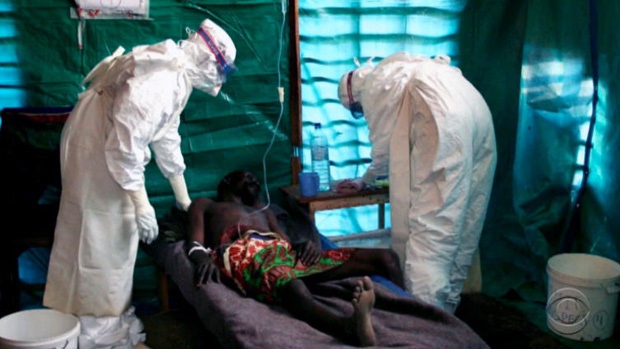Science Seen Physicist and Time One author Colin Gillespie helps you understand your world.
Ebola Concepts You May Want to Understand
Ebola is a scary virus. Most know it is deadly. It is an international problem. We need evidence-based action to solve it, not play-on-fear border closings (c.f., SARS and swine flu) that do no good but damage the economy. We need a public conversation on ebola and it might be aided by some terms you may soon hear. Though technical, they express simple ideas.
Every epidemic disease has a number: R0, the basic reproduction number, is the average number of persons who get infected by one infected person. An epidemic spreads when R0 is greater than 1.0; it’s simple math. In average circumstances each infectious disease has a characteristic R0 value. For example, R0 for measles is about 15; and R0 for ebola is about 2. So measles is much more infectious than ebola.
 But the spread of an infectious disease also depends on actual circumstances. If an infected person lives and dies alone (or in an isolation ward with proper procedures) they infect no-one, so R0 is effectively zero. The way to end an epidemic is to control the circumstances to bring its local R0 value below 1.0. Past ebola epidemics have occurred in rural settings that were relatively easy to control. Now ebola is an urbanized epidemic: It is loose in crowded West African cities. There, control is harder to achieve. News correspondents describe scenes like this:
But the spread of an infectious disease also depends on actual circumstances. If an infected person lives and dies alone (or in an isolation ward with proper procedures) they infect no-one, so R0 is effectively zero. The way to end an epidemic is to control the circumstances to bring its local R0 value below 1.0. Past ebola epidemics have occurred in rural settings that were relatively easy to control. Now ebola is an urbanized epidemic: It is loose in crowded West African cities. There, control is harder to achieve. News correspondents describe scenes like this:
Nurses, some not wearing gloves and others in street clothes, clustered by the door as pools of the patients’ bodily fluids spread to the threshold.
Often there still are no gloves for nurses. In such circumstances, ebola epidemics spread in hospitals. They are then called nosocomial, a concept that’s up close and personal for me as Science Seen readers may recall. Senior Fellow for Global Health at the Council on Foreign Relations Laurie Garrett says:
All twenty-one [ebola] epidemics have been nosocomial, meaning that they’ve spread within a medical setting.
One consequence is that infection and death rates are far higher among health workers than among the population, including even workers who had no contact with infected persons. In 2007 Daniel Bausch and eight other authors studied ebola transmission in an isolation ward. They use a word we may have call to use more often: fomites. A fomite is:
… an inanimate object (as a dish, toy, book, doorknob, or clothing) that may be contaminated with infectious organisms and serve in their transmission.
The low R0 value for ebola assumes the mode of transmission is direct contact with bodily fluids. The study considers an additional mode of transmission, by fomites. Bausch et al say:
We conclude that [ebola virus] is shed in a wide variety of bodily fluids during the acute period of illness but that the risk of transmission from fomites in an isolation ward and from convalescent patients is low when currently recommended infection control guidelines for the viral hemorrhagic fevers are followed.
In other words, well-run hospitals are safe. Sadly, this rings hollow: Few infected persons in this outbreak are in isolation wards, and infection-control guidelines are often not followed. We don’t know if fomites are a new mode of transmission. This would increase the R0 value.
Garrett says there has been and still is a failure to grasp the exponential growth of this epidemic, with numbers of infected persons doubling every twenty days, reflecting an R0 value greater than 1.0. She says:
The officially reported numbers are almost irrelevant.
Her observations make sense to me. In March, ten million dollars might have established control. Today the United States alone (it’s not alone) is throwing some two billion dollars at it ($1B cash and 3,000 troops). This could have done the job two months ago. Now, twenty billion might not be enough. Guessing low will be expensive: If you don’t stamp out a runaway exponential, it can get so far ahead of you you will not recognize your world. So, more of too-little, too-late, is just a waste of cash. Swift and overwhelming action now can bring R0 down and stop the epidemic. It’s simple math.
In the end the issue’s the economy. Look for that word too, to soon be in the news.
Sources:
Adam Nossiter (2014), “Outracing Vows of Aid, Ebola Swamps a City Unprepared for It”, New York Times, New York: The New York Times Company, October 2, p. A1; http://www.nytimes.com/2014/10/02/world/africa/ebola-spreading-in-west-africa.html?_r=0
Laurie Garrett (2014), Charlie Rose, September 2, panel discussion, http://www.charlierose.com/watch/60454096
Merriam-Webster online dictionary, http://www.merriam-webster.com/medical/fomite
Daniel Bausch et al (2014), “Assessment of the Risk of Ebola Virus Transmission from Bodily Fluids and Fomites”, Journal of Infectious Diseases, Arlington: Infectious Diseases Society of America, vol. 196, p. S142; http://jid.oxfordjournals.org/content/196/Supplement_2/S142.full
Other reading:
Summary of ebola facts: CBC News, http://www.cbc.ca/news/health/ebola-outbreak-here-s-what-you-need-to-know-1.2786511
Image credit:Daniel Schwartz (2014), http://www.cbc.ca/news/health/ebola-outbreak-more-than-doctors-needed-to-contain-west-africa-s-unprecedented-crisis-1.2720882

No comments yet.